DS4000 Rigol Waveform Examples
Scott Prahl
March 2021
This notebook illustrates shows how to extract signals from a .wfm file created by a the Rigol DS4000 scope. It also validates that the process works by comparing with .csv and screenshots.
Two different .wfm files are examined one for the DS4022 scope and one for the DS4024 scope. The accompanying .csv files seem to have t=0 in the zero in the center of the waveform.
If RigolWFM is not installed, uncomment the following cell (i.e., delete the #) and run (shift-enter)
[1]:
#!pip install --user RigolWFM
[2]:
import numpy as np
import matplotlib.pyplot as plt
try:
import RigolWFM.wfm as rigol
except ModuleNotFoundError:
print('RigolWFM not installed. To install, uncomment and run the cell above.')
print('Once installation is successful, rerun this cell again.')
repo = "https://github.com/scottprahl/RigolWFM/raw/master/wfm/"
A list of Rigol scopes that should have the same file format is:
[3]:
print(rigol.DS4000_scopes)
['4', '4000', 'DS4000', 'DS4054', 'DS4052', 'DS4034', 'DS4032', 'DS4024', 'DS4022', 'DS4014', 'DS4012', 'MSO4054', 'MSO4052', 'MSO4034', 'MSO4032', 'MSO4024', 'MSO4022', 'MSO4014', 'MSO4012']
DS4022 Waveform
Look at a screen shot
Start with a .wfm file from a Rigol DS4022 scope. It should looks something like this

Import the .wfm data
[4]:
# raw=true is needed because this is a binary file
name = "DS4022-A.wfm"
wfm_filename = repo + name + "?raw=true"
w = rigol.Wfm.from_url(wfm_filename, '4000')
downloading 'https://github.com/scottprahl/RigolWFM/raw/master/wfm/DS4022-A.wfm?raw=true'
First a textual description.
[5]:
description = w.describe()
print(description)
General:
File Model = wfm4000
User Model = 4000
Parser Model = wfm4000
Firmware = 00.02.03.00.03
Filename = DS4022-A.wfm
Channels = [1, 2, 3, 4]
Channel 1:
Coupling = DC
Scale = 50.00 V/div
Offset = 0.00 V
Probe = 10X
Inverted = False
Time Base = 1.000 µs/div
Offset = 500.000 ns
Delta = 2.000 ns/point
Points = 7000
Count = [ 1, 2, 3 ... 6999, 7000]
Raw = [ 215, 222, 227 ... 20, 20]
Times = [-6.500 µs,-6.498 µs,-6.496 µs ... 7.498 µs, 7.500 µs]
Volts = [137.50 V,148.44 V,156.25 V ... -167.19 V,-167.19 V]
Channel 2:
Coupling = DC
Scale = 200.00 V/div
Offset = 0.00 V
Probe = 100X
Inverted = False
Time Base = 1.000 µs/div
Offset = 500.000 ns
Delta = 2.000 ns/point
Points = 7000
Count = [ 1, 2, 3 ... 6999, 7000]
Raw = [ 127, 127, 127 ... 127, 127]
Times = [-6.500 µs,-6.498 µs,-6.496 µs ... 7.498 µs, 7.500 µs]
Volts = [ -0.00 V, -0.00 V, -0.00 V ... -0.00 V, -0.00 V]
Channel 3:
Coupling = DC
Scale = 50.00 V/div
Offset = 0.00 V
Probe = 10X
Inverted = False
Time Base = 1.000 µs/div
Offset = 500.000 ns
Delta = 2.000 ns/point
Points = 7000
Count = [ 1, 2, 3 ... 6999, 7000]
Raw = [ 65, 57, 49 ... 236, 236]
Times = [-6.500 µs,-6.498 µs,-6.496 µs ... 7.498 µs, 7.500 µs]
Volts = [-96.88 V,-109.38 V,-121.88 V ... 170.31 V,170.31 V]
Channel 4:
Coupling = DC
Scale = 200.00 V/div
Offset = 0.00 V
Probe = 100X
Inverted = False
Time Base = 1.000 µs/div
Offset = 500.000 ns
Delta = 2.000 ns/point
Points = 7000
Count = [ 1, 2, 3 ... 6999, 7000]
Raw = [ 127, 127, 127 ... 128, 127]
Times = [-6.500 µs,-6.498 µs,-6.496 µs ... 7.498 µs, 7.500 µs]
Volts = [ -0.00 V, -0.00 V, -0.00 V ... 6.25 V, -0.00 V]
Now for the actual signal
[6]:
toff=0.05
ch=w.channels[0]
plt.title("CH%d %.2fV/div %.2fVoff (%s %s)" % (1,ch.volt_per_division, ch.volt_offset, w.basename, w.firmware))
plt.plot(ch.times*1e3,ch.volts, color='blue', label='WFM')
plt.legend(loc='lower right')
plt.xlabel("Time (ms)")
plt.ylabel("Voltage (V)")
plt.show()
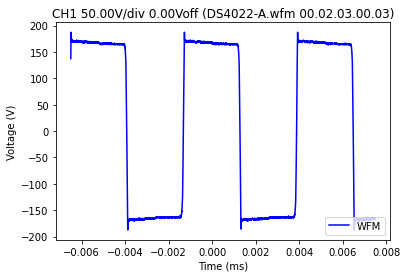
[7]:
# Note that CH3 and CH4 are both effectively zero, just displaced in the display graph above
w.plot()
plt.show()
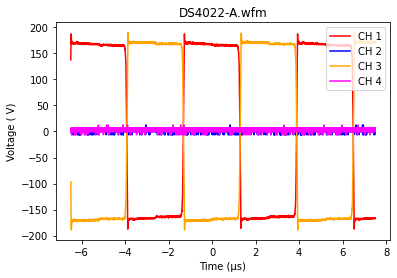
DS4024 Waveform
Start with importing the .csv data
[8]:
filename = "DS4024-A.csv"
csv_filename = repo + filename
csv_data = np.genfromtxt(csv_filename, delimiter=',', skip_header=2).T
# need to do this separately because only the start and increment is given in the csv file
time = csv_data[0] * 2.000000e-06 - 1.400000e-03
Plot the .csv data
[9]:
plt.plot(time*1000,csv_data[1], color='blue')
plt.plot(time*1000,csv_data[2], color='red')
plt.xlabel("time (ms)")
plt.ylabel("Volts (V)")
plt.title("DS4024-A")
plt.show()
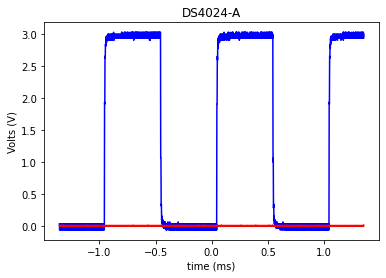
Import the .wfm data
[10]:
# raw=true is needed because this is a binary file
name = "DS4024-A.wfm"
wfm_filename = repo + name + "?raw=true"
w = rigol.Wfm.from_url(wfm_filename, '4')
downloading 'https://github.com/scottprahl/RigolWFM/raw/master/wfm/DS4024-A.wfm?raw=true'
Now describe the .wfm data
[11]:
print(w.describe())
General:
File Model = wfm4000
User Model = 4
Parser Model = wfm4000
Firmware = 00.02.03.02.00
Filename = DS4024-A.wfm
Channels = [1, 2]
Channel 1:
Coupling = DC
Scale = 1.00 V/div
Offset = -576.00 mV
Probe = 1X
Inverted = False
Time Base = 200.000 µs/div
Offset = 100.000 µs
Delta = 4.000 ns/point
Points = 700000
Count = [ 1, 2, 3 ... 699999, 700000]
Raw = [ 109, 109, 109 ... 205, 206]
Times = [-1.300 ms,-1.300 ms,-1.300 ms ... 1.500 ms, 1.500 ms]
Volts = [ 13.50 mV, 13.50 mV, 13.50 mV ... 3.01 V, 3.04 V]
Channel 2:
Coupling = DC
Scale = 200.00 mV/div
Offset = 0.00 V
Probe = 1X
Inverted = False
Time Base = 200.000 µs/div
Offset = 100.000 µs
Delta = 4.000 ns/point
Points = 700000
Count = [ 1, 2, 3 ... 699999, 700000]
Raw = [ 126, 127, 127 ... 127, 127]
Times = [-1.300 ms,-1.300 ms,-1.300 ms ... 1.500 ms, 1.500 ms]
Volts = [ -6.25 mV, -0.00 V, -0.00 V ... -0.00 V, -0.00 V]
Finally compare the .wfm data to the .csv data
[12]:
toff=0.05
ch=w.channels[0]
plt.title("CH%d %.2fV/div %.2fVoff (%s %s)" % (1,ch.volt_per_division, ch.volt_offset, w.basename, w.firmware))
plt.plot(ch.times*1e3,ch.volts, color='blue', label='WFM')
plt.plot(time*1e3+toff,csv_data[1], color='red', label='CSV')
plt.legend(loc='lower right')
plt.xlabel("Time (ms)")
plt.ylabel("Voltage (V)")
plt.xlim(-1.5,2)
plt.show()
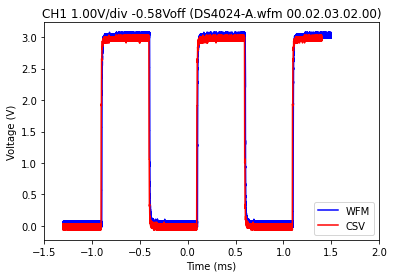
[13]:
toff=0.0565
ch=w.channels[1]
plt.title("CH%d %.2fV/div %.2fVoff (%s %s)" % (2,ch.volt_per_division, ch.volt_offset, w.basename, w.firmware))
plt.plot(ch.times*1e3,ch.volts, color='blue', label='WFM')
plt.plot(time*1e3+toff,csv_data[2], color='red', label='CSV')
plt.legend(loc='lower right')
plt.xlabel("Time (ms)")
plt.ylabel("Voltage (V)")
plt.xlim(-0.5,1.0)
#plt.ylim(-0.02,0.02)
plt.show()
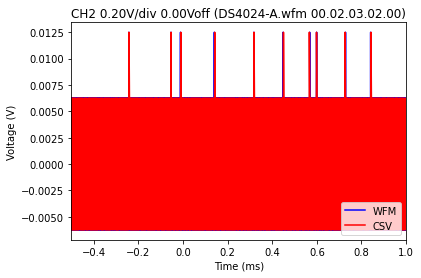
[ ]: